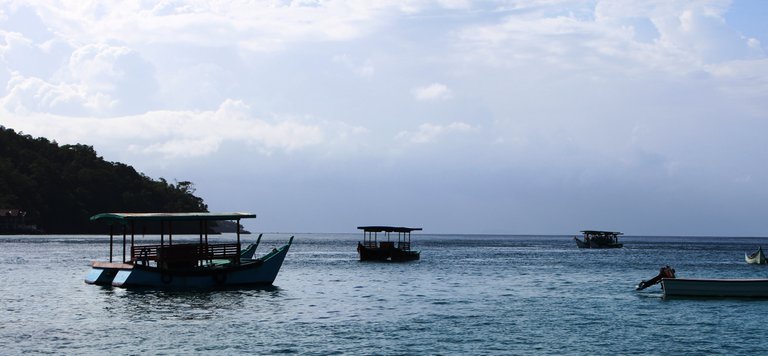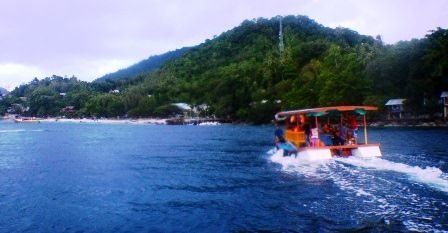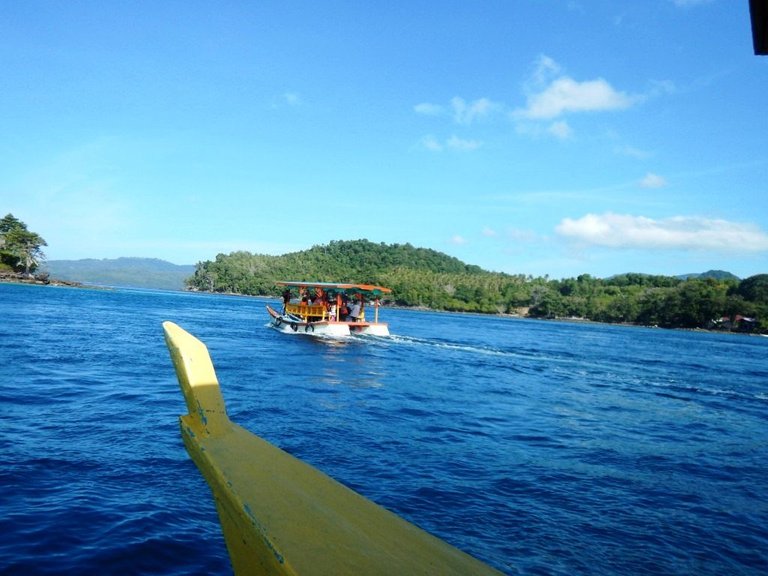not many objects of historical relics in Sabang because Sabang is now a cool tourist place, beautiful especially the marine park. unfortunately I have not been able to take more photos. this is all I can give to my friends all
History of Sabang
Around 301 BC, a Greek earth expert, Ptolomacus sailed eastward and anchored on an unknown island in the mouth of the Strait of Malacca, Weh! Then he mentioned and introduced the island as the Golden Island on the map of the sailors.
In the 12th century, Sinbad made a voyage from Sohar, Oman, away through the Maldives route, Kalkit Island (India), Sri Lanka, Andaman, Nias, Weh, Penang and Canton (China). Sinbad docked on Weh Island and renamed it Gold Island.
Arab traders who sailed to the island of the Web named it Shabag which means Mount erupted. Perhaps this is where Sabang comes from, from Shabag. From other sources it is said that the name Weh Island comes from the Aceh language which means separate. This island was once used by the Sultan of Aceh to exile the exiles.
Before the Suez Canal was opened in 1869, the Indonesian archipelago was reached through the Sunda Strait from the direction of the African Continent, but after the Suez Canal was opened the path to Indonesia became shorter through the Strait of Malacca. Due to the nature of the harbor with deep waters and well protected nature, the Dutch East Indies government at that time decided to open Sabang as a dock. Pulau Weh and Sabang city before World War II were the most important ports in the Malacca Strait, much more important than Temasek (now Singapore). Widely known as a natural harbor named Kolen Station operated by the Dutch colonial government since 1881.
In 1883, the Sabang pier was opened for a boat docked by the Atjeh Association. Initially, the port was used as a coal base for the Royal Netherlands Navy, but later also included a merchant ship to ship export goods from northern Sumatra. In 1887, Firma Delange, assisted by Sabang Haven, obtained the authority to add, build port facilities and facilities. The free harbor era in Sabang was started in 1895, known as Vrij Haven and managed by Sabang Maatschaappij.
Currently every year, 50,000 ships pass through the Strait of Malacca so that in 2000, the Indonesian government declared Sabang a Free Trade Zone and Free Port to benefit by establishing the Sabang port as a logistics hub for overseas ships passing through Malacca. Infrastructure for docks, ports, warehouses and facilities to refuel are being developed.
The most important thing for Weh history is that since the harbor in Sabang. Around the year 1900, Sabang is a fishing village with harbors and a good climate. Then the Dutch built a coal depot there, the harbor deepened, utilizing the terrain, so that a place that could hold 25,000 tons of coal had been awakened. Steam vessels, coal-fired ships, from many countries, stop by to pick up coal, fresh water and other existing facilities. Before World War II, the port of Sabang was very important compared to Singapore. At the time when diesel-powered boats were used, Singapore became more needed, and Sabang began to be forgotten.
In 1970, the government of the Republic of Indonesia planned to develop Sabang in various aspects, including fisheries, industry, trade and others. Sabang Port itself eventually became a free port and became one of the most important ports in Indonesia. But finally closed in 1986.
History of Sabang and Pulau Weh
Speaking of history, Sabang's name itself comes from Arabic, Shabag which means mountain erupted. Why did the mountain erupt? maybe long ago there are still many volcanoes that are still active in Sabang, it can still be seen in volcanoes in Jaboi and Volcano in the sea of Laot Men.
Around 301 BC, a Greek earth expert, Ptolomacus sailed eastward and anchored on an unknown island in the mouth of the Strait of Malacca, Weh! Then he mentioned and introduced the island as the Golden Island on the map of the sailors.
In the 12th century, Sinbad made a voyage from Sohar, Oman, away through the Maldives route, Kalkit Island (India), Sri Lanka, Andaman, Nias, Weh, Penang and Canton (China). Sinbad anchored on an island and renamed it Golden Island, the island that people now know by the name of Weh Island.
While Weh Island is derived from the word in Aceh, "Weh" which means moving, according to the history of Pulau Weh in circulation initially united with the island of Sumatra, because something finally Weh Island, we become ourselves today. position. That island is called Pulau Weh. Based on the historical narrative of the residents of Gampong Pie Ulee Lheueh, Pulau Weh previously proceeded with Ulee Lheue. Ulee Lheue in Banda Aceh is actually Ulee Lheueh (separate). It was rumored that the volcano erupted and caused this area to separate. As well as Java and Sumatra first, separated by Krakatau erupted. Weh Island is famous for the island of Kita without H, there is the assumption that weh island named our island is because of its shape like the letter W.
The history of Pulau Weh is since the harbor in Sabang City. Around the year 1900, Sabang is a fishing village with harbors and a good climate.
Then the Dutch built a coal depot there, the port deepened, utilizing the terrain, so a place that could hold 25,000 tons of coal had awakened. Steam vessels, coal-fired vessels, from various countries, stop by to pick up coal, fresh water and other existing facilities, this can be seen with the many heritage buildings of the Netherlands.
Before World War II, Sabang port was very important compared to Singapore. However, when a diesel-powered marine vessel was used, Singapore became more needed, and Sabang began to be forgotten.
History of Sabang City
Indonesia zero point starts from this island. The island is located on the outer edge and is the gateway of the country's western region. Various names and nicknames have been mentioned by sailors to small islands that have natural beauty to the bottom of this ocean. Even the various interpretations are also given on his new name which consists of only three letters: w-e-h.
Pulau Weh has two deep and sheltered bays, namely Sabang and Balohan, as a natural harbor. Also the source of clean water and its strategic location. So it is not surprising that various events have occurred on this island. After the opening of the Suez Canal in 1869, the Indonesian archipelago was no longer affordable from the south, via the Sunda Strait. But through the more northerly lane, the Strait of Malacca, and of course through Pulau Weh. Unfortunately, the written data only records the number 1881 as the earliest year of Weh Island recorded in the history of authentic writing.
In 1881 the Dutch established Kolen Station in the famous bay of Sabang with its original port. In 1883 founded Atjeh Associate by Factorij van de Nederlandsche Handel Maatschappij (Dutch Trade Society Factory) and De Lange & Co in Batavia (Jakarta) to operate the port and coal station in Sabang. The harbor is intended as a coal station for the Dutch Navy, but later also serves a general merchant ship. In 1895 Kolenstation was completed and can accommodate 25,000 tons of coal derived from the Ombilin coal mine in West Sumatra. The port also provides fuel oil shipped from Palembang. Steamers from various countries, stop by to pick up coal, fresh water and other facilities. Before World War II, Sabang port was very important compared to Singapore.
Year 1896 Sabang opened as a free port (vrij haven) for general trading and as a port of transit goods mainly from Deli agriculture which has been a tobacco plantation since 1863 and pepper plantation products, areca nut and copra from Aceh itself, Sabang is becoming known by world trade and shipping traffic.
In 1899 Ernst Heldring recognized the potential of Sabang as an international port and proposed the development of the Sabang port at Nederlandsche Handel Maatschappij and several other Dutch companies through his book Oost Azie en Indie. In 1899 Balthazar Heldring as director of NHM changed Atjeh Associate to N.V. Zeehaven en Kolenstation Sabang Te Batavia (Sabang Port and Batavia Coal Station), which became known as Sabang Maatschappij and rehabilitated port infrastructure into an international port. In 1903, CJ Karel Van Aalst as the new NHM director arranged a biweekly service between the Sabang port and the Netherlands, involving Stoomvaart Maatschappij Nederland and Rotterdamsche Lloyd. In addition, he also arranged an important capital injection for Sabang Maatschappij with NHM as the majority shareholder.
In 1942 In World War II, Sabang was occupied by Japan and made the base of the western defense. Sabang as free harbor closed.
In 1945 Sabang received two attacks from Allied forces and destroyed some of the infrastructure. Then Indonesia Merdeka but Sabang still a territory of the Dutch colony.
Year 1950 After KMB, Dutch return Sabang to Indonesia. The ceremony took place at the Controleur building (Dharma Wanita building now). Then through the decision of the Minister of Defense of the Republic of Indonesia Number 9 / MP / 50, Sabang became the Base of Maritime Defense of the Republic of Indonesia. Sabang Maatschappij is liquidated. The process was completed in 1959. All assets of Sabang Maatschappij Port were purchased by the Government of Indonesia.
In 1963, the Research Team from Syiah Kuala University Banda Aceh in cooperation with the Indonesian Exsport Association of Sumatera conducted a study on the possibility of Sabang reopening into a free port, because of its strategic location in the inter-state trade sector. Then through Presidential Decree No. 10 of 1963, Sabang was designated as Free Port, and its implementation was handed over to the Supreme Commander of Economic Operations (KOTOE).
Year 1964 Established an institution Command Executor Development of Sabang Free Port Project (KP4BS) through Presidential Regulation of the Republic of Indonesia number 22 of 1964.
In 1965 Sabang Municipality was established by Law no. 10 of 1965.
Year 1970, issued Law no. 3 of 1970 and No. 4 of 1970 on the principal terms of free trade with Sabang port and on free trade area with free port for 30 years, with the following functions:
Produces stockpiling of consumer goods and production for import, export, re-export or industrial trade.
Performing upgrading, processing, manufacturing, packing, repacking, and marking.
Growing and developing industries, trade traffic, and transportation.
Provide and develop infrastructure and expedite port facilities, develop ports, shipping, transit transactions, and others.
Endeavor to develop tourism and efforts towards incarnate and terbinanya shopping center. -During and developing other activities especially in trade, maritime, transportation, banking and insurance sector.
In 1985 Sabang status as a Free Trade Area and Sabang Free Port was closed by the Government of Indonesia through Law no. 10 Year 1985, by reason of the rampant smuggling and will open Batam as Free Trade Area and Free Port. 1993 The position of Sabang began to be reconsidered with the establishment of Regional Economic Cooperation Indonesia-Malaysia-Thailand Growth Triangle (IMT-GT).
Year 1997 Implementation of Science and Technology Jamboree initiated by BPPT at Pantai Gapang, Sabang, to review the development of Sabang.
In 1998 the City of Sabang and Pulo Aceh Sub-district was designated as an Integrated Economic Development Zone (KAPET) which together with the other KAPET was inaugurated by President BJ Habibie with Presidential Decree no. 171 dated 26 September 1998.
In 2000 President KH. Abdurrahman Wahid proclaimed Sabang as a Free Trade Zone and Free Port and on January 22, 2000 was issued Presidential Instruction No. 2 Year 2000
September 1, 2000 issued Government Regulation in Lieu of Law No.2 of 2000 on Free Trade Area and Sabang Free Port.
On December 21, 2000 was issued Law no. 37 of 2000 on Free Trade Area and Sabang Free Port.
In 2002 the port activity of Sabang began to pulsate again with the entry of goods from abroad to Sabang area.
Year 2004 This activity was stopped because Aceh was designated as Military Emergency Area.
December 26, 2004 Sabang also experienced the earthquake and Tsunami. Then the Reconstruction and Rehabilitation Agency (BRR) of Aceh-Nias established Sabang as an air and sea transit point for tsunami aid and the delivery of construction materials and others to be used in Aceh. History of Sabang i take From various sources.
.




Hello! It's nice to see you here! Hope you enjoy it on here as much as I do.
thank you, I really hope we can be successful together. @kunilfalah
Welcome to Steem. Do read A thumb rule for steemit minnows - 50:100:200:25 for starter tips.
Also get to know more about Steem reading the Steem Blue Paper and share your feedback on our Steem Blue Paper Awareness Initiative
All the Best!!!
thank you, this info is very useful for me. @kunilfalah